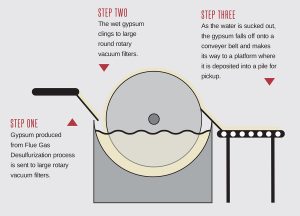One of the byproducts of modern coal plant operations is a fluffy, cakelike substance called gypsum.
Thicker than sand, but porous, synthetic gypsum is a much sought-after product for the wallboard, cement and agricultural industries. Gypsum is manufactured from the very substance that the scrubber system removes from coal plant exhaust gas – sulfur dioxide.
Gypsum’s chemical makeup, combined with its texture and other properties, make it highly desirable as a soil amendment rich in calcium sulfates — properties that can turn the claylike southern Indiana soil into more tillable land.
When wet, it absorbs like those paper towel commercials, preventing runoff and soil erosion. Heat it, then add water and it is rock solid, a desirable attribute for the cement industry.
Production of synthetic gypsum reduces the need to mine for natural deposits and significantly reduces the amount destined for disposal in a power plant’s landfills.
Hoosier Energy’s Merom Generating Station began producing resale quality gypsum in March 2016 and sales quickly began exceeding projections.
As of June 1, 2017, more than 75,000 tons of gypsum have been sold and shipped by truck and rail to businesses throughout Indiana.
Herb Abbott, area coordinator for FGD and a 30-year veteran at the plant, said most people don’t realize how the environmentally friendly product is produced. “A lot goes into removing sulfur dioxide from the flue gas stream of a coal-fired power plant that folks just don’t know about,” he said.
“The one thing that amazes me is instead of spending millions to maintain a landfill and cap it, we can now load most of this up on a truck and put it on a field,” Abbott said. “It’s not waste anymore. It’s something good, and it came from coal.”
Learn more about how the gypsum process works at the Merom Generating Station at https://youtu.be/og-0sqyYJ9o.
How synthetic gypsum is formed
 Synthetic gypsum is a sulfate that results from flue gas desulfurization (FGD) at a coal plant.
Synthetic gypsum is a sulfate that results from flue gas desulfurization (FGD) at a coal plant.
The FGD process removes up to 98 percent of sulfur dioxide from the power plant’s air emissions. During the FGD process, a mixture of water and crushed limestone slurry is injected into a module with exhaust gas from the boiler where “scrubbing” of the impurities takes place. The calcium carbonate in the limestone reacts with the sulfur dioxide in the flue gas to form calcium sulfate dihydrate, or gypsum.



